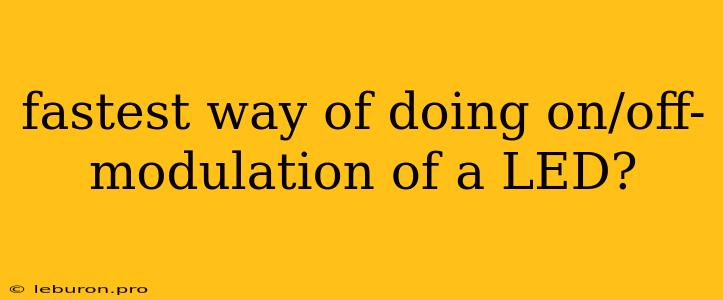The Fastest Way to Modulate LEDs: A Deep Dive into Techniques and Considerations
The ability to rapidly switch LEDs on and off, known as modulation, is crucial in a range of applications. From high-speed data transmission and advanced lighting effects to medical imaging and LiDAR systems, the speed of LED modulation directly impacts performance. In this article, we'll delve into the fastest ways to modulate LEDs, exploring the techniques, trade-offs, and considerations for achieving optimal results.
Understanding the Basics of LED Modulation
Before diving into the fastest methods, let's establish a foundational understanding of LED modulation. At its core, it involves rapidly changing the current flowing through an LED to control its light output. This can be achieved by manipulating the voltage applied to the LED or by using specialized modulation techniques.
The speed of LED modulation is primarily determined by two factors:
- The LED's intrinsic response time: This refers to how quickly the LED can physically respond to changes in current. Factors like the LED's construction, material, and junction capacitance contribute to its intrinsic response time.
- The speed of the driving circuitry: The electronics used to control the LED's current flow also play a significant role. The switching speed of transistors, the response time of control circuits, and the overall design of the driving circuitry all impact the modulation speed.
The Fastest Modulation Techniques: A Comparative Analysis
Several techniques can be employed for modulating LEDs, each offering different performance characteristics and trade-offs. Let's examine the most widely used and fastest methods:
1. Direct Current Modulation (DCM):
- Principle: Directly switching the LED on and off by controlling the current flow through it using transistors or other switching elements.
- Pros: Simplicity, low cost, high speed potential.
- Cons: Can generate electromagnetic interference (EMI), potentially causing noise in nearby circuits.
2. Pulse Width Modulation (PWM):
- Principle: Varying the duration of the "on" time (duty cycle) of a square wave signal driving the LED.
- Pros: Highly efficient, low EMI, wide range of dimming control.
- Cons: Requires precise timing and control, can introduce some switching artifacts at high frequencies.
3. Current Steering:
- Principle: Directing the current flow between multiple LEDs using transistors, allowing for rapid switching between them.
- Pros: Can achieve very high switching speeds, suitable for high-frequency applications.
- Cons: Increased complexity and cost compared to DCM or PWM.
4. High-Speed Drivers:
- Principle: Utilizing specialized integrated circuits (ICs) designed for high-speed LED driving and modulation.
- Pros: Optimized for performance, can achieve very fast modulation rates, minimal switching losses.
- Cons: Higher cost, may require specialized knowledge for implementation.
5. Digital Signal Processing (DSP) Techniques:
- Principle: Utilizing digital signal processing algorithms to generate complex modulation patterns and control the LED's light output.
- Pros: Enables precise control over light intensity, allows for complex modulation waveforms, flexibility in generating various light effects.
- Cons: Increased complexity and computational resources needed, may have limitations in achieving ultra-high frequencies.
Achieving Fastest Modulation: Key Considerations
While the techniques mentioned offer various pathways to fast modulation, several factors influence achieving optimal performance.
1. LED Selection:
- Fast Response Time: Opt for LEDs with inherently low junction capacitance and fast response times.
- Low Capacitance: Minimize the LED's capacitance to reduce the time required for current changes to propagate through the device.
2. Driving Circuit Optimization:
- Low Inductance: Minimize the inductance in the driving circuit to reduce the time required for the current to rise and fall.
- High-Speed Transistors: Use high-speed transistors with low switching times for efficient current control.
3. Impedance Matching:
- Matching Circuit Impedance: Carefully match the impedance of the driving circuit to the LED's impedance to minimize signal reflections and optimize power transfer.
4. Heat Management:
- Efficient Cooling: Ensure adequate heat dissipation to prevent the LED from overheating and degrading its performance, especially at high modulation frequencies.
5. Electromagnetic Interference (EMI) Control:
- Shielding and Filtering: Employ appropriate shielding and filtering techniques to minimize EMI and ensure compatibility with other electronic systems.
6. Power Supply Considerations:
- Stable and Fast Power Source: Utilize a stable power supply with low ripple and fast response times to provide reliable current for the LED driver.
Conclusion
Achieving the fastest on/off-modulation of LEDs requires a holistic approach that considers various factors. Selecting the right technique, optimizing the driving circuitry, and carefully managing the LED's thermal characteristics are key to maximizing speed and minimizing performance limitations. By applying these principles, engineers can achieve the rapid and precise LED modulation required for cutting-edge applications in diverse fields.
